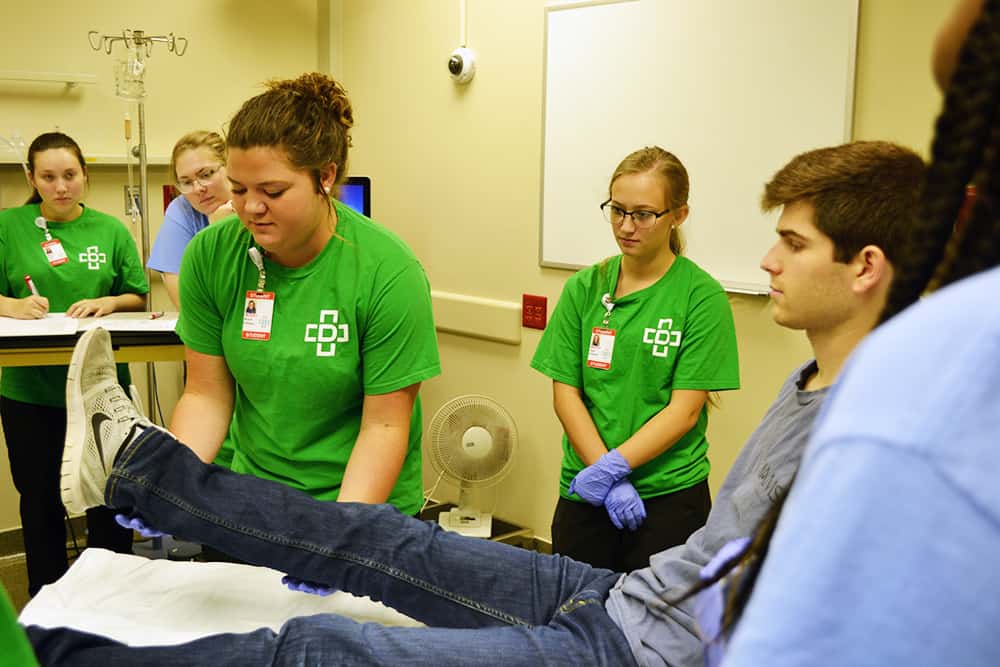AR SAVES Uses Simulation to Teach Students about Stroke
| Aug. 14, 2018 | Although the high school students in the UAMS Simulation Center this summer may not have been stroke doctors or nurses yet, they got a chance to play those roles on TV and learn to recognize stroke symptoms.
For almost a decade, AR SAVES has been educating school children about stroke, and this summer the program through roleplaying and telemedicine added another innovation to that effort.

AR SAVES health educator Erin Pace talks with MASH students as Tiffany Morgan looks on through the SAVES network monitor and camera system.
The Arkansas Stroke Assistance through Virtual Emergency Support (AR SAVES) has used telemedicine, and its network of hospitals, to reduce the time it takes for a stroke patient to receive treatment with alteplase, a powerful clot-busting blood thinner. Telemedicine also reduces the time it takes for a stroke patient to see the stroke neurologist who can diagnose and help them.
More than 300 students in June and July visited the Simulation Center to roleplay how to diagnose someone with stroke symptoms and how to get them treatment under the direction of a neurologist during a live video consultation.
The students were participating in MASH (Medical Applications of Science for Health) camp. MASH camp is a two-week summer enrichment program that allows rising high school juniors and seniors to shadow health professionals and attend workshops that enhance their experience in the health care field. UAMS Regional Campuses for many years has organized the camps in communities throughout Arkansas.
AR SAVES health educators Olivia Wilson and Erin Pace working with AR SAVES nurses and Call Center staff played the role of stroke neurologists on a live video feed. They walked the students through the roles of the Emergency Department nurses and physicians. They showed them how these people in their hometowns diagnose stroke patients using the AR SAVES network. All the students were from towns in which the local hospital is a network member. Member hospitals number 54 and allow the most rural areas of the state to have access to a stroke neurologist 24/7.
Pace said before the workshop in the center, only a few students recognized the BE FAST mnemonic used to help people remember what symptoms to look for. It stands for Balance, Eyes, Face, Arm, Speech and Time.
“At first, they were a little shocked and uneasy about being on camera and talking to the physician on screen,” Pace said. “That was new to them. I explained to them this is on the forefront of medicine and will allow care in rural communities that otherwise would not be available. They said it was a good scenario and gave them a good experience. They acclimated quickly.”
Students examined the mock patients’ arms and legs for mobility and paralysis and looked for slurred speech and facial drooping. They also gained experience questioning them and other volunteers playing the role of patients’ family members.
After the simulations, Pace said all the students were surveyed about BE FAST, and all of them knew what it meant. They all expressed confidence that they now could recognize a stroke and would act quickly to get treatment for a stroke patient.
“Without the neurologist guiding you, there are so many signs of stroke that most people wouldn’t even know such as holding an arm up,” said Cheyenne Barnes, a senior at Parker’s Chapel High School near El Dorado. “No one is going to know to do that to check for signs of a stroke. I think we learned a lot of signs and symptoms to look out for.”
Barnes said that on a tour of the Medical Center of South Arkansas in El Dorado, she was able to see the monitor and equipment used there to connect the hospital to AR SAVES stroke neurologists.
“In El Dorado, we don’t have a neurologist,” Barnes said. “The closest one is in Shreveport, Louisiana. To be able to have the telemedicine right there if someone comes in with a stroke, you can quickly get an assessment. That’s great, especially for rural communities to have that.”

